Asexuality is the Invisible Orientation.
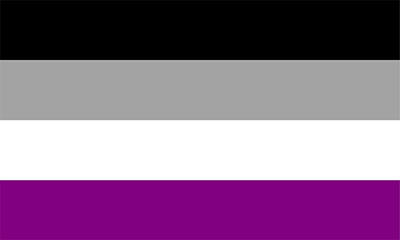 The Asexual Pride flag, first introduced in 2010
The Asexual Pride flag, first introduced in 2010
Asexuality is a sexual orientation, just as Homosexuality, Bisexuality, Pansexuality and Heterosexuality etc. are. It is not even a ‘new’ sexuality, it is simply not well known, and correspondingly not well understood by those who are not Asexual themselves.
Asexuality is not a hormone imbalance, nor a medical issue*. It is not a mental health issue*, and it does not need to be cured. Asexuality is also neither abstinence nor celibacy, both of which are conscious behavioural choices that any person of any sexuality may engage in.
If a person identifies as Asexual, it simply means that they either do not experience sexual attraction to any person, or they experience it so rarely or only under very specific circumstances that it is notable enough to fall on the Ace Spectrum.
The Spectrum
Asexuality falls under what is known as the Ace Umbrella. Much like the Trans Umbrella, a few different, but related, identities are covered.
-
Asexuality = experiences no sexual attraction
- Graysexuality/Gray-Asexuality = experiences very little sexual attraction, or only in certain circumstances
- Demisexuality = experiences sexual attraction only once a deep emotional relationship has been formed
It should be noted that Asexuals are not all also Aromantic, which also falls under the Ace Spectrum umbrella.
- Aromantic = experiences no romantic attraction
- Grayromantic/Gray-Aromantic = experiences very little romantic attraction, or only in certain circumstances
- Demiromantic = experiences romantic attraction only once a deep emotional relationship has been formed
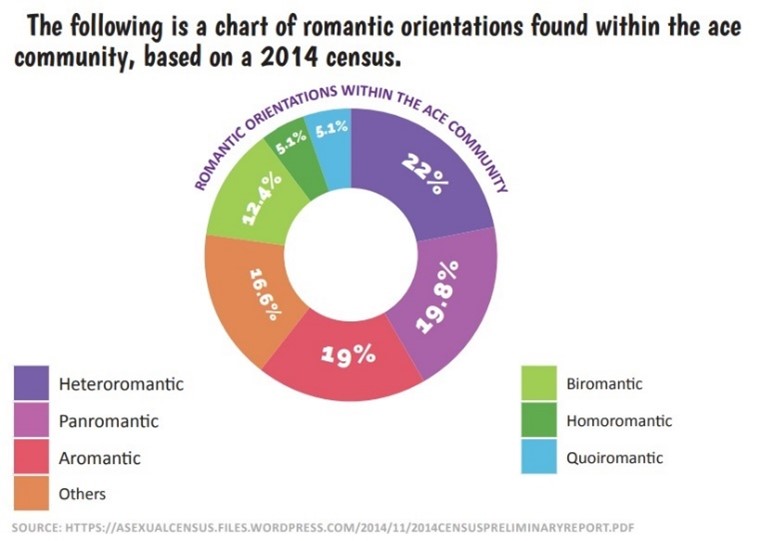 Romantic Orientation Chart; data compiled 2014 by Asexual Outreach
Romantic Orientation Chart; data compiled 2014 by Asexual Outreach
Asexuals could be any combination of the above, and thusly also could be Gay, Lesbian, Bi, Pan or Hetero, based on their romantic attraction. This is called the Split Attraction Model, wherein a person can have a different romantic orientation from their sexual orientation. For example, I am a Non-Binary Pan-Demi-Romantic Asexual, and often simply go by Queer as a means of simplifying things, because that’s a bit of a mouthful, even for me!
Further to these terms, there are also sex-positive, sex-repulsed (a personal identifier, not a judgement, that means they are repulsed by the act when they are included in it) and sex-neutral Asexuals. There are Asexuals with average, below-average and above-average libidos, just as there are for any other sexuality, and the behaviour of having or not having sex is a personal choice, independent of their orientation.
A Brief History
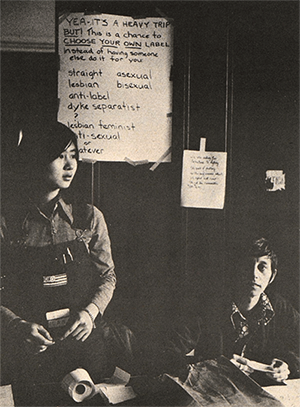 A rare historical photograph clearly indicating asexuality inclusion in 1973. Pollner, F. (1973). Lesbian dynamics. Off Our Backs, 3(6), 7-7.
A rare historical photograph clearly indicating asexuality inclusion in 1973. Pollner, F. (1973). Lesbian dynamics. Off Our Backs, 3(6), 7-7.
On the Kinsey Scale, (first published in 1948) Asexuality is listed as "X", which indicates "no socio-sexual contacts or reactions" with 1.5% of male interviewees falling at this point on the scale, and in 1953, 19% of female interviewees falling at this point. Though it has been noted – first in 1977 when Michael D. Storms published a study reimagining the Kinsey Scale – that the way Kinsey conducted his study suggests that Asexuals may have been wrongly categorised as Bisexual, as they may have expressed no strong preference, and that female sexuality at the time was severely misunderstood.
The Asexual Manifesto (transcription) was first published in 1972 by Lisa Orlando, where Asexuality was described as “...if one has sexual feelings they do not require another person for their expression, Asexuality is, simply, self-contained sexuality.” The manifesto makes for interesting reading on what could be seen as a reaction to Political Lesbianism of the feminist movement of the era. The Asexuality described in the Manifesto is in some ways very close to current definitions, but in others, very different.
There have been articles, studies and books, (such as Boston Marriages: Romantic but Asexual Relationships Among Contemporary Lesbians by Esther D. Rothblum and Kathleen A. Brehony, released in 1993) published regularly since the 1980s, but in 2001 the community found its first major online hub in the form of David Jay’s Asexuality Visibility and Education Network (AVEN), the network is still going strong and provides resources and community.
Since then the community has grown, adopted a symbol (a black ring worn on the right-hand middle finger), had our first Pride Parade entry (in San Francisco, 2009), created a Pride Flag (2010, see above!) and has been growing in awareness and support, with a handful of asexual characters appearing in television shows and other media, (Todd Chavez in BoJack Horseman; Liv Flaherty, in Emmerdale; Parvati Holcomb, in The Outer Worlds; Florence, in Sex Education; Reyna Avila Ramírez-Arellano, in The Heroes of Olympus etc; Ruby Hale, in Agents of S.H.I.E.L.D), many new books and studies being released, podcasts (Sounds Fake But Okay) and George Norman became Britain’s first out asexual politician in 2015.
The Other One Percent
Asexuality is still so little known and little understood by anyone outside of the community that it is colloquially known in the LGBTQIA community as the Invisible Orientation, so much so that there is a book so entitled, an introduction to asexuality by Julie Sondra Decker (2014).
It is thought that Asexuality makes up about 1% of the population – whereas roughly 1.6% identify as gay or lesbian, and 0.7% as bisexual
It is thought that Asexuality makes up about 1% of the population – whereas roughly 1.6% identify as gay or lesbian, and 0.7% as bisexual – and we can be found across the romantic and gender spectrums, as well as found across the world and across societies.
It is hoped that with the growing community and growing awareness, that no more young asexuals will grow up feeling broken in a society overly saturated with sexual imagery and the social expectations of how and when relationships should progress.
* A loss of sexual attraction, or a loss of libido, for someone who was not previously dealing with these things may indicate an underlying issue, however, and if it is causing distress it is recommended to talk to a GP or counsellor.
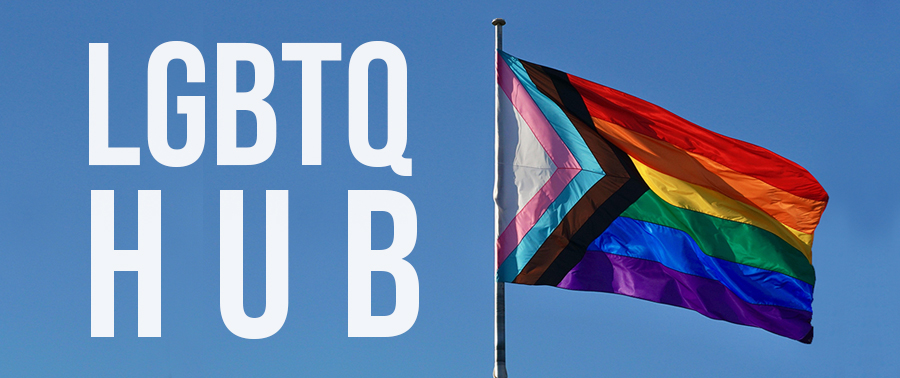 Click on the banner to check out more related content from our LGBTQ+ HUB
Click on the banner to check out more related content from our LGBTQ+ HUB

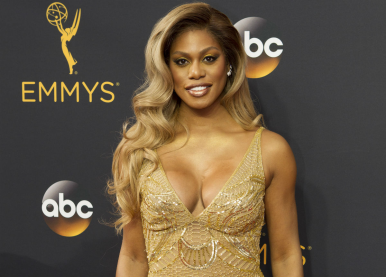
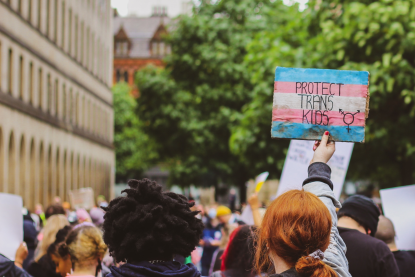

Rate and Review
Rate this article
Review this article
Log into OpenLearn to leave reviews and join in the conversation.
Article reviews